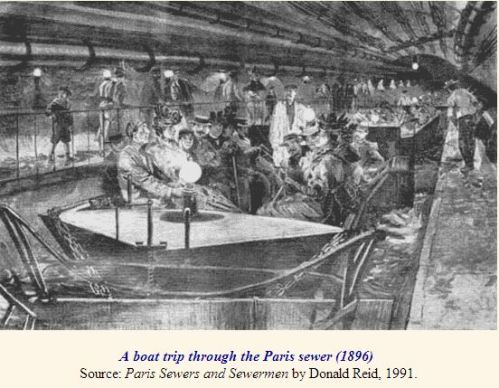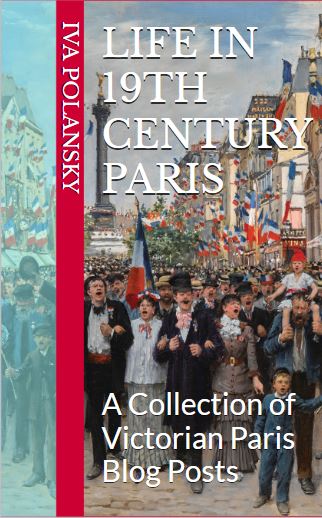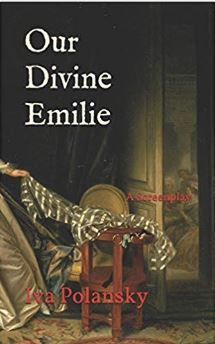
(From Paris Partout! A guide for the English and American Traveller in 1869 or How to see PARIS for 5 guineas)
Paris, the City of Light, is a veritable charivari of pleasures after nightfall; the visitor must only beware of not regretting the effects of a too-eager readiness to yield to the siren calls of its temptations and intoxications.
Theatres, cafés chantants and dancing halls
The Grand Opéra, rue Pelletier. Properly the French Opera, run up in a hurry in 1821(to replace a building in the rue de Richelieu, at the door of which the Duc de Berri was stabbed and which was pulled down in consequence). In front of the portico, three dastardly Italians tried to assassinate the Emperor and the Empress in 1858, and now this building is being replaced too, by a splendid edifice designed by M. Garnier, due to open in 1871. The government provides 900,000 francs of annual subsidy. Peformances on Monday, Wednesday, Friday, and often Sunday.
The Opéra Comique, Place des Italiens. In this handsome hall are presented lighter works, by modern composers such as Aber, Halévy, etc.
The Théâtre Italien, Place Boildieu. Here a select audience listens to Italian Opera, in a season which lasts from November to April (after which the singers generally repair to London).
The Théâtre Français, rue Richelieu. The seat of the French regular drama – classic works and modern alike, with a government subsidy of 240,000 francs. Molière was once its manager; in later years it has been the scene of triumphs of Talma and Rachel. The manager is allowed to withdraw an actor from any other theatre to the Comédie-Française (as it is also known) on one year notice.
The Odéon, near the Luxembourg. A minor Théâtre Français, but not an inferior one. Here Beaumarchais’ play Le Mariage de Figaro was first produced in 1784; nine years later, the entire troop of actors was arrested by order of the Revolutionary tribunal. It has several times been burnt down.
Théâtre des Variétés, Boulevard Montmartre. A neat and much-frequented house, in which the amusing musical vaudevilles of M. Offenbach can be seen.
The infamous Boulevard du Temple, or ‘Boulevard du Crime’, on which the smaller theatres played the most lurid and distasteful melodrama, has now been destroyed to make way for the regime’s march of progress.
The Théâtre Gymnase-Dramatique, Boulevard Bonne Nouvelle, is respectable. The plays are moral and the performers are all married.
Note Ladies do not patronize the pit, or parterre, of any theatre; gentlemen admitted here should in the interval ensure their places by tying a handkerchief around the banquette. Be also warned that at the Grand Opéra, the claque sit here. This disagreeable cohort, paid by the management in this and other theatres to respond favourably to the entertainment in question, should on no account be shushed or silenced in their mercenary activities. An attempt to abolish the claques in 1853 proved totally unsuccessful after a fortnight.
Tickets for all Parisian theatrical performances may be booked from a central office on the Boulevard des Italiens; avoid the profiteers who swarm outside the more popular theatres – their offers are always excessive in price, and frequently entirely bogus!
Cafés chantants. Spectators sit and listen to music, sometimes of a coarse nature, executed by performers often outrageously overdressed. No charge is made for admission, but one will be expected to take refreshment, usually of inferior quality. The company is not aristocratic, but the visitor need not fear annoyance or impropriety. The most celebrated of these institutions is L’Alcazar, rue du Faubourg Poissonière. Here the fabulous Theresa, whose salary exceeds 20,000 fr. per annum, sings, twice a week in the winter season, ditties of a satirical and even saucy turn.
Balls publics. It is difficult to imagine scenes more curious or fantastic than those presented by these public dancing halls. At the most refined level, balls masqués are presented during the winter in the Grand Opéra – the pit being boarded over and joined to the stage. Gentlemen may be admitted (10 fr.) in plain evening clothes, but ladies should be masked or in costume. The gorgeous and glittering revelry of the polka, waltz, and mazurka reaches its climax at 1 a.m. Strict etiquette is by no means the predominating characteristic of the fair who resort to this pleasantest of pandemonia. It will be conceived that if a visitor should take the ladies of his family to witness this display, he must take them to a box as a mere spectators, for to mingle with any of these too vivacious groups, could be worse than indiscretion.
Elsewhere public dancing halls abound. Some of the smaller establishments in the suburbs are little more than dens of all the vices: official efforts to curb their activities and proliferation have not been altogether effective.
In the centre of the city, more commodious establishments may be found, among them the Salle Valentino, rue S. Honoré. The architecture is a medley of the Moorish and Greek; the columns are gaily painted, and the recess is backed by mirrors which greatly enhances the brilliancy of the scene. There are a billiard table, a shooting gallery, a dynamometer for amateurs of muscular strength, and tables where trifles may be raffled for. The visitor must expect to see every variety of embrace not excepting the ursine hug. Admission 2-3 fr.
Jardin Mabille, Avenue Montaigne. A large circular space, with a pavilion for the orchestra in the centre, is reserved for the dancers, and lighted by a profusion of gas-lights suspended from artificial palm trees. A snug corner is laid out for refreshment; here the votary of Terpsichore may treat his partner to a refreshing lemonade. An immense covered saloon affords the visitor a secure asylum from bad weather. The company of this elegant garden comes under the description of ‘the gayest of the gay’, but licence is not carried beyond propriety. Admission 2 fr.
Would that the same could be said of the Salon de Wauxhall, rue de la Douane, which partakes of the character of the manufacturing arrondissement surrounding it, and is not much more respectably attended than the Holborn Casino! The police make forays on its bacchic excesses, and arrests are made.
A novel and hilarious diversion is provided by an American importation. In the Roller Skating Club, rue Jean Goujon, skating on shoes soled with rubberized wheels is demonstrated daily by ‘Professor’ Fuller, a master of the Art who claims to have been ‘decorated by every Sovereign in the world with ice in his dominions’. The first of such institutions in Europe.
Next: Sightseeing
Read Full Post »



















